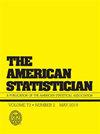Vardeman, S. B. and Morris, M. D. (2013), "Majority Voting by Independent Classifiers can Increase Error Rates," The American Statistician, 67, 94-96: Comment by Baker, Xu, Hu, and Huang and Reply.
IF 1.8
4区 数学
Q1 STATISTICS & PROBABILITY
引用次数: 1
Abstract
Vardeman and Morris (VM) found a counterexample to the assertion that a majority voting classifier always performs better than its independent component classifiers. VM's counterexample applies to independent classifiers, but biostatisticians are often more interested in conditionally independent classifiers. In biomedical studies, where class is disease status, classifiers are inherently dependent simply because positivity of any reasonable classifier depends on the presence or absence of disease. Conditional independence of classifiers, given disease status, could arise if the classifiers are detecting different biological phenomenon, such as tissue abnormalities versus protein markers. To explore how majority voting affects classification performance with conditionally independent classifiers, we investigated many examples (Figure 1). Much as we expected, we found that it generally works quite well. However, we also found that conditional independence is not a sufficient condition to ensure that majority voting always leads to better classification performance than the individual classifiers. Figure 1 Comparison of ROC curves for majority voting classifier and conditionally independent component classifiers. The 45-degree line is included for reference. As with VM, we considered two classes and component classifiers with identical classification performances. To measure classification performance we used receiver operating characteristic (ROC) curves. ROC curves play a central role in the evaluation of diagnostic and screening tests (Baker 2003; Pepe 2003). In accordance with a decision theory view of ROC curves (Baker, Van Calster, and Steyerberg 2012), we restricted our investigation to ROC curves that are concave, namely with monotonically decreasing slopes from left to right. For a given cutpoint x of a score, let fpr(x) and tpr(x) denote the false positive and true positive rates of the component classifier. The ROC curve for the component classifier plots tpr(x) versus fpr(x). At a given cutpoint, the true positive rate for the majority voting classifier is the probability of three or exactly two true positives among the component classifiers, namely tprM(x) = tpr(x)3 + 3 tpr(x)2 {1−tpr(x)}. Similarly the false positive rate for the majority voting classifier is fprM(x) = fpr(x)3 + 3 fpr(x)2 {1−fpr(x)}. The ROC curve for the majority voting classifier plots tprM(x) versus fprM(x). We considered the following six cases.

Vardeman, S. B.和Morris, M. D.(2013),“独立分类器的多数投票会增加错误率”,《美国统计学家》,67,94-96:Baker, Xu, Hu, and Huang的评论和回复。
本文章由计算机程序翻译,如有差异,请以英文原文为准。
求助全文
约1分钟内获得全文
求助全文
来源期刊

American Statistician
数学-统计学与概率论
CiteScore
3.50
自引率
5.60%
发文量
64
审稿时长
>12 weeks
期刊介绍:
Are you looking for general-interest articles about current national and international statistical problems and programs; interesting and fun articles of a general nature about statistics and its applications; or the teaching of statistics? Then you are looking for The American Statistician (TAS), published quarterly by the American Statistical Association. TAS contains timely articles organized into the following sections: Statistical Practice, General, Teacher''s Corner, History Corner, Interdisciplinary, Statistical Computing and Graphics, Reviews of Books and Teaching Materials, and Letters to the Editor.
 求助内容:
求助内容: 应助结果提醒方式:
应助结果提醒方式:


